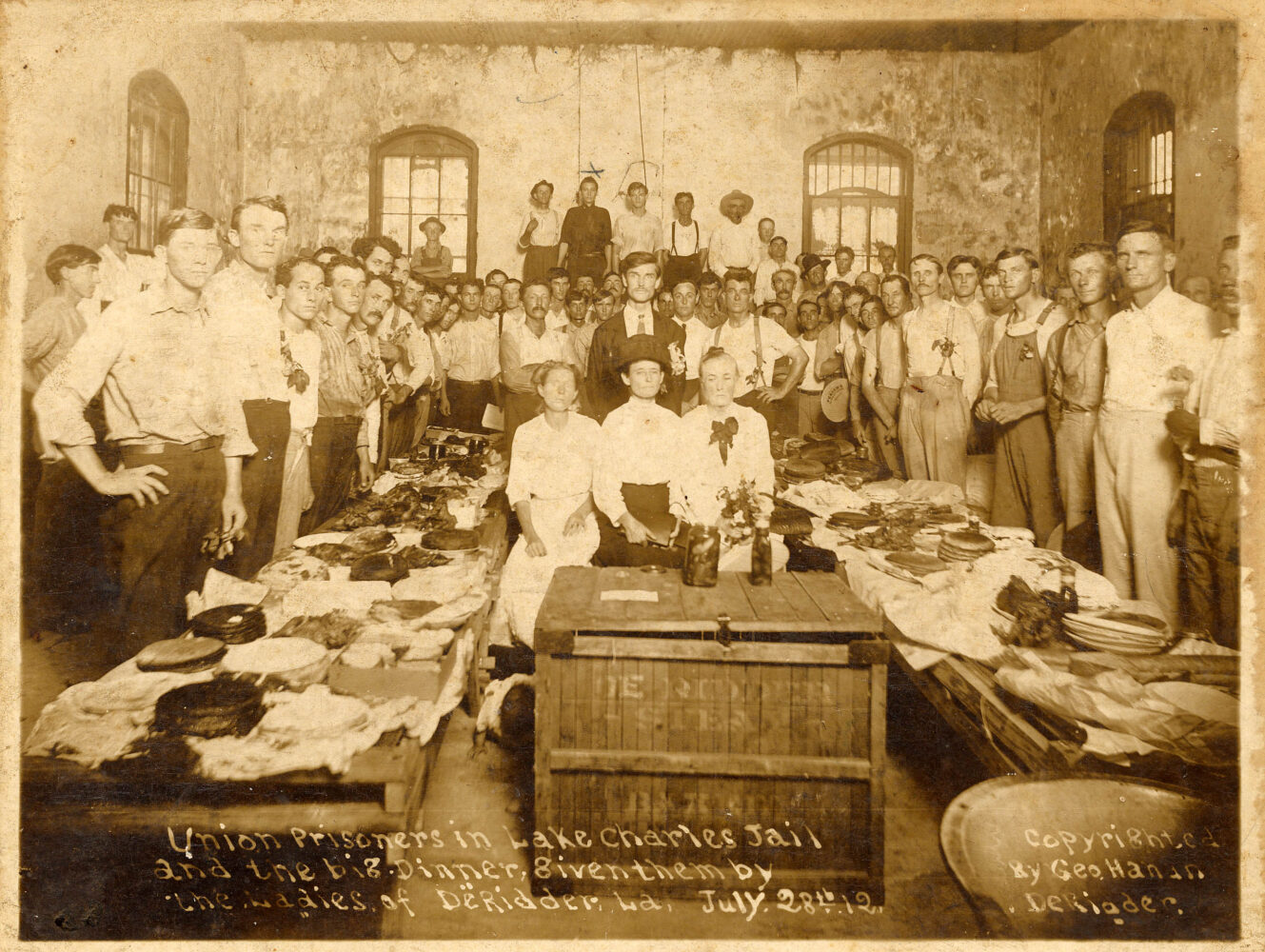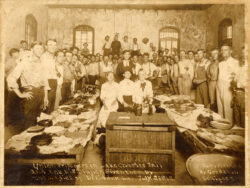Grabow Riot (Massacre)
Labor union meeting results in death and arrest of timber workers.

Southwest Louisiana Photograph Collection, Archives and Special Collections Department, Frazar Memorial Library, McNeese State University.
Union members in jail after the Grabow Riot (Massacre), 1912.
The Grabow “riot” (as the lumber mill owners called it), or the “massacre” (as the timber workers saw it), was a violent attack on a Brotherhood of Timber Workers (BTW) meeting held on a public road in the unincorporated town of Grabow, on US Highway 171 just outside De Ridder, in Beauregard Parish, on July 7, 1912. The attack took place near the mill owned by John Galloway, who, unbeknownst to the union members, had planned an ambush. Galloway armed himself, his young sons, and several loyal company employees and allegedly fired the first shot into the crowd. Though a few armed men in the BTW ranks returned fire, they were hopelessly outgunned by the local lumber companies’ men, who had stockpiled an arsenal. In the melee that followed, at least four people were killed and forty injured, including women and children. One of the dead was a union guard. This violent encounter and the subsequent arrest of more than sixty union men—who were held without bail in the torrid summer heat of 1912 in the Calcasieu Parish jail (or “cesspool,” as investigators dubbed it)—was the beginning of the end for the BTW.
When Lumber Was King
By the early twentieth century Louisiana was one of the top three lumber producers in the United States, along with Texas and Mississippi. According to historian James Fickle, “the piney woods region of western Louisiana and East Texas were a lumberman’s bonanza.” Timber companies grew rich at the expense of the mainly Black and white workers hired to cut over the vast untouched stands of longleaf yellow pine, at the time a highly sought-after commodity. Left alone for centuries to grow as nature intended—slowly—this pine was exceedingly dense and so strong that it was used for the ties in the Cape Town-to-Cairo railroad, among other things. The mill owners, who helped to build the towns of western Louisiana, did not pass along their immense profits to their employees, who were ruthlessly exploited in company-owned towns.
Timber workers frequently walked out on strike, demanding better pay and healthier, more humane working and living conditions. The employers, rather than listening and responding sympathetically to workers’ pleas, responded by forming a cabal, the Southern Lumber Operators Association (SLOA), to pool their resources and share intelligence. Employers had far more resources and organizing skills than the workers, who, without the support of the state or federal government, which was lacking in this era, were bound to lose this battle.
Company-Sponsored Mob Violence Against Union Organizers
The mill owners fired and blacklisted union members, employed scab labor during strikes, and used violence to defeat workers’ attempts to organize. Many union members suffered brutality at the hands of private armies hired by employers. The most famous incident of anti-union mob violence was the Grabow massacre. Accounts about what happened differ. While the union members said they were ambushed, the company claimed that a mob had broken into the homes of the guards. Despite overwhelming evidence that the violence had been the work of Galloway and his armed accomplices, Calcasieu Parish Sheriff Henry Reid and his deputies arrested dozens of workers—and none of the perpetrators, even though Galloway had reportedly shot in the back a man who was attempting to flee. The only people indicted were sixty men and three women associated with the union. The one of them who eluded arrest—Leather Britches Smith—was shot in the back and killed while in hiding (the shooters reported that he was resisting arrest).
“Chamber of Horrors” in the Calcasieu Parish Jail
Denied bail, the sixty indicted men were forced into a single cell with one faucet and one toilet. It was the heat of the summer, and the sewer system was barely functioning. According to local lore, it was a “chamber of horrors.” The men endured these conditions for months, during which time they were never allowed outside for exercise. They were supported by their home communities and the women of Beauregard and Calcasieu Parishes, who brought food to the underfed jailed workers. The defense described them as political prisoners. The trial of the first nine defendants began in Lake Charles on October 7, 1912, and concluded October 31, 1912. The jury deliberated only one hour and returned an acquittal. Charges against all the others were dropped, but the expenses of supporting the defendants and their families for months and paying attorneys’ fees bankrupted the BTW.
While the trial was underway, the SLOA took over the pro-union American Lumber Company in Merryville with the help of the British-owned Santa Fe Railroad company, which had a controlling interest in the American Lumber Company. When the company fired fifteen union men who had appeared as witnesses for the defense in Lake Charles, the union called a strike and set up a union hall (meeting place) in an abandoned church. The owners brought in new workers as scab labor, many of whom were unaware that a strike was on, and reopened the mill. To discourage violence, women and children picketed outside the mill and at the train depot when scabs came in. Fredonia Stevenson, a hotel owner and the BTW’s secretary, not only led picketers but, after authorization by the BTW, wrote the Bureau of Investigation (predecessor to the Federal Bureau of Investigation) to demand that it investigate, in her words, the unconstitutional abuse of power by lumber mill owners, demanding “redress of wrongs.” Female union members and BTW sympathizers not only established a soup kitchen to feed the hungry families of striking workers, they formed picket lines and reportedly assaulted scabs with hatpins.
The situation escalated and in February 1913, the SLOA unleashed a mob of armed drunk men to destroy the union’s facilities in Merryville and attack the leaders. The thugs ransacked the Union Hall, attacked women and other pickets at the mill, and pulled down the soup tent. Some striking workers were thrashed and jailed, while others were forced out of town. Some leaders fled for their lives, only to be hunted down, beaten, and left for dead.
None of the men who perpetrated the violence against the workers were ever prosecuted. Local authorities made it clear that they would never take legal action against mill owners and their allies, thus sending a signal to workers that if they challenged employers’ control, they could be brutalized and killed with impunity. The repressive tactics used by owners and their hired guns destroyed the BTW, which maintained a feeble presence in some locales for a couple more years but was effectively destroyed, never to be revived. Eventually, federal and state labor laws that resulted from workers’ demands in this industry, as well as in many others, would ameliorate the worst abuses in the workplace.
